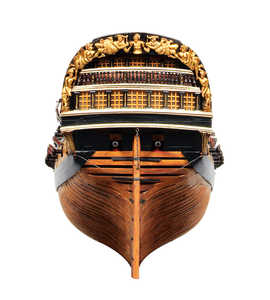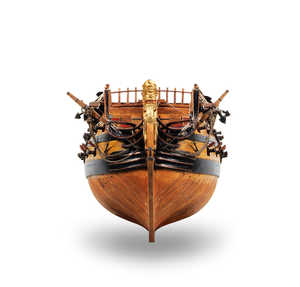Ships-of-the-line. Eighteenth century Mendean
The ship-of-the-line was the most powerful warship of the
age of sail. A country’s naval power was measured by the
number of ships-of-the-line it boasted; these ships had two
or even three rows of guns on each side, and could singlehandedly
determine the course of great sea battles.
Initially, many ships-of-the-line in the Spanish navy were
built in Basque shipyards, although this work was later moved
to other areas. Many Basque carpenters and workmen
specialising in the construction of ships-of-the-line were hired
by the royal shipyards elsewhere on the Iberian peninsula
and in the territories abroad.
Initially the ship-of-the-line, which was larger than the frigate,
proved top-heavy and unstable because of the weight of
its guns. Antonio de Gaztañeta from Mutriku developed an
innovative system for designing the underwater hull which
notably increased the stability of the ship without reducing
its speed. This method, based on a system of graphs, also
ma-de it possible to predetermine exactly the shape of the
fore and aft parts of the hull, which had previously depended
on improvisation and the good workmanship of each builder.

Beech and fir forest in Irati, Navarre. The spars on the shipsof-
the-line were bigger than any ever seen before, requiring the
tallest trees in the forest. Because of its shape, strength and lightness
the fir was the best suited species for making masts, with
pieces shaped in the Pyrenees of up to 35 metres in length.
Transpor-ting these huge masts through the mountains posed a
major engineering challenge in itself. At the same time, construction
of a medium-sized ship-of-the-line consumed over 2,000
mature oaks. This massive demand led to deforestation throughout
much of Europe. © José Lopez

Until the eighteenth century, ships-of-the-line were steered
using an extension running at right angles to the tiller, which was
controlled by the helmsman from the poopdeck. Increased tonnage
made it very difficult to sail such large ships with this system,
and the ship's wheel was developed, employing a system of pulleys, to make the helmsman's work easier. © José Lopez

Aft and fore views of a ship-of-the-line. -Aft. -Fore. © José Lopez

Aft and fore views of a ship-of-the-line. -Aft. -Fore. © José Lopez
![90-gun ship. Plan by Gaztañeta. Arte de fabricar reales [The
art of manufacturing royal vessels. A manuscript explaining how
naval ships were to be built ]](../argazkiak/p/145.jpg)
90-gun ship. Plan by Gaztañeta. Arte de fabricar reales [The
art of manufacturing royal vessels. A manuscript explaining how
naval ships were to be built ]. © José Lopez

These ships, true floating cathedrals, were considered to be
the last word in Basque shipbuilding technology. The ship depicted
here is a 90-gun ship-of-the-line, built in 1720. © José Lopez

Altogether, between sailors and marines, a medium-sized ship
of the line required a crew of around seven hundred. In order to
feed and house so many people, four or five decks were required,
which also housed the spare parts, ammunition, guns, etc. This lack
of space and hygienic conditions meant that disease was one of the
commander's primary concerns. © José Lopez

The ships kept getting bigger and bigger, as more decks were
added; as in the case of the frigates, the sails were developed,
leading to a notable improvement when sailing close to the wind.
The ship's wheel was introduced, making it easier to steer the vessel. © José Lopez








![90-gun ship. Plan by Gaztañeta. Arte de fabricar reales [The
art of manufacturing royal vessels. A manuscript explaining how
naval ships were to be built ]](../argazkiak/p/145.jpg)



